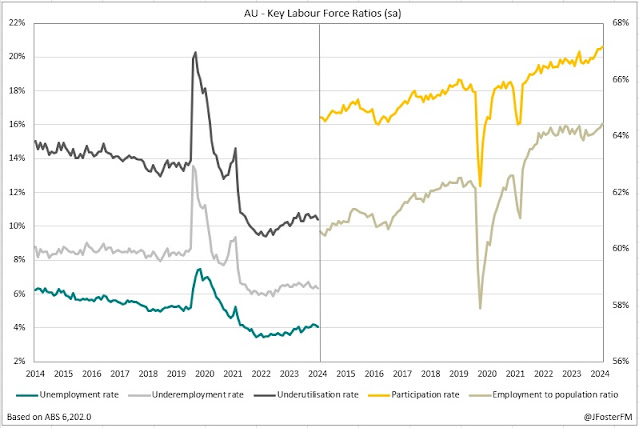A very strong Australian Labour Force Survey for September has prompted markets to adjust for a more delayed start to the RBA's easing cycle, the first cut repriced from February to April 2025. Employment accelerated by more than 64k in September, the 6th consecutive upside surprise on expectations as labour demand continues to defy a backdrop of slower growth in Australia and offshore. The unemployment rate (4.1%) came in below expectations as the participation rate reached a new record high (67.2%).
By the numbers | September
- Employment increased by a net 64.1k in September (full time +51.6k/part time +12.5k), well above the 25k consensus. August's 47.5k rise was revised down to 42.6k.
- The national unemployment rate printed at 4.1% (vs 4.2% expected), unchanged from a downwardly revised 4.2% in August. Underemployment fell from 6.5% to 6.3%. Total labour force underutilisation declined from 10.6% to 10.4%, a low since March.
- Labour force participation lifted to a new cycle high, rising from 67.1% to 67.2%, while the employment-to-population ratio also touched record highs at 64.4%.
- Hours worked advanced by 0.3% in the month to be up by 0.8% across the September quarter. Annual growth accelerated from 1.7% to 2.4%, its fastest pace in 12 months.
The details | September
Employment surged to a 64.1k rise in September, its strongest outcome since February and the 6th consecutive upside surprise on the market forecast. Full time employment (51.6k) drove the headline outcome in September - after briefly falling in August (-5.9k) - and was supported by an increase in the part time segment (12.5k). Underscoring the current momentum in the labour market - and defying the backdrop of a slower economy - employment gains for the 3 months to September averaged 51.9k, the strongest pace since the middle of last year. Furthermore, employment lifted by 156k across the September quarter, the largest quarterly rise since Q1 2023.
The unemployment rate printed at 4.1% in September, up from the cycle lows of around 3.5% at the end of 2022 but still at a low level. Robust employment growth - partly attributable to the support to demand from a rising population - has played a key role in limiting the rise in unemployment as labour force participation has continued to reach new highs. Broader measures of spare capacity show that tightness in the labour market has eased, but underemployment (6.3%) and underutilisation (10.4%) remain materially below their levels prior to the pandemic.
Hours worked posted a 0.3% rise in September to be up by 2.4% over the year. Monthly hours were volatile through the middle part of the year, due partly to illness-related absences. In recent months, however, hours worked have increased steadily, seeing a 0.8% lift in the September quarter.
In summary | September
Today's report reaffirms the strength of the Australian labour market. Employment continues to rise at pace amid record-high participation in the labour force, holding the unemployment rate at a low level. Given the labour market conditions, the RBA remains focused on inflation and a significant surprise would be needed in the Q3 CPI report (30 October) via softer core inflation and services prices to shift the Board from its narrative that rate cuts are not on its radar in the near term.







